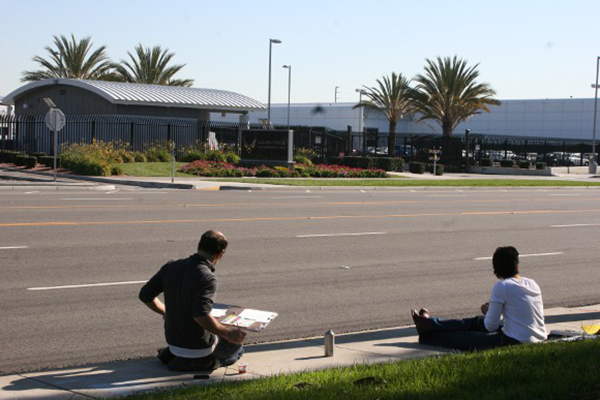Last December, I was sitting on a stretch of grass on a quiet Southern California public street with a small group of artists and writers facing the entrance to the Los Angeles Air Force Base. We were sketching, reading poetry and chatting about the peculiarities of the landscape around us, our personal relationships with it, family in the military, and so on. When our quiet drawing session caused minor alarm for three officers in the United States Department of Defense Police Force stationed there, our conversation turned to the legality of looking. Ultimately, we were allowed to continue drawing that morning. However, we learned that if we had come on another day, it could have been considered a national security threat. (More on the event is in a story by KCET here, and more on the law is here.)
Though El Segundo is pervaded by contractors, it's easy to miss this hub of military activity. When I first imagined coming out to El Segundo to draw the Los Angeles Air Force Base, I was hoping to draw on the base grounds. The Public Affairs officer I spoke with didn't think the base had much of interest to offer artists. There are no airplanes, helicopters, nor airstrips. The base itself is a gated office park for pushing papers dealing with military contractors. The surrounding area appears mundane, a mixture of mid-century suburban tract homes and national defense businesses shaped by ideals of leisure, comfort and security. However, as a place to look and draw, this seemingly unremarkable neighborhood is charged. This drawing event in El Segundo became the inaugural session for a series of "draw-ins," to be held at other militarized zones around Southern California in the coming months.
Enclosed walkway over El Segundo Blvd., bridging the Los Angeles Air Force Base and Aerospace Corporation | Photo : Brian Moss
The idea for the draw-in came from my desire to connect our idealized palm-dotted Southern California landscape and U.S. military activities in similar subtropical regions abroad. While drawing is commonly a solitary, meditative pursuit, my idea was to use the tradition of drawing outdoors as a way to generate a collective vision of seemingly remote conflict. Despite or perhaps because of the mediated nature of news coverage, the difficulties of life during war remains abstract in the daily lives of American civilians, especially those without personal ties to the military. My hope is that this project will help us bring these seemingly distant situations home through a new type of engagement with landscape, art, and looking.
Poets Diane Ward and Jane Sprague | Photo : Brian Moss
Sketching in groups, painting outside, and creating picturesque landscapes have long traditions that inform the concept of the draw-in. In the early 19th Century, British painter John Constable used plein air sketching ("open air") to focus on the countryside he lived in as a subject, rather than a backdrop, while industrialization increasingly encroached upon the land. His work inspired the Barbizon School and subsequent movements including the Impressionists, who popularized the activity further. Plein air painting also has a rich history here in California, where it gained a critical mass in the Post-Impressionist era of the early 20th Century. Amateurs and professionals sketched and painted outdoors in groups, often romanticizing the landscapes as commercial and political lines were increasingly drawn upon the region.
The idyllic in landscape has also been employed by boosters, developers, governments, and militaries to promote their causes. In the 19th Century, colonizing European empires illustrated their interests and conquests in exotic foreign subtropical lands, popularizing this imagery in engravings, panoramic paintings, and domestic decorations like wallpaper and tea services. Since the early 20th Century, Southern California's palm studded skyline has conjured idyllic notions of similar far away lands and balmy paradises in our own backyard. The draw-in allows us to explore this romanticized imagery while forming connections to related battlegrounds abroad.
Watercolor by Robby Herbst | Photo : Hillary Mushkin
A series of draw-ins will be held in the next several months, focusing on militarized parts of Southern California embedded into our landscape. Participants will be invited to "trace" their environment, both literally and metaphorically, through any manner of media including sketching, mindfully walking, measuring and mapping. Such acts of closely observing and drawing the subject at length involve a process of engagement that is haptic and encourages thinking. They allow time for participants to consider the ways in which landscape imagery can be a tool for understanding war and conflict, and the experience of conflict. At the same time, our acts of personal tracing become a type of witnessing which gains power through collective and public observation.
Hillary Mushkin is a visual artist exploring contemporary and historical intersections of art, visual culture, social and political consciousness. She works in studio and post-studio forms including drawing, media, and interactive formats. Mushkin frequently collaborates with others from fields including poetry, architecture, and digital media.




